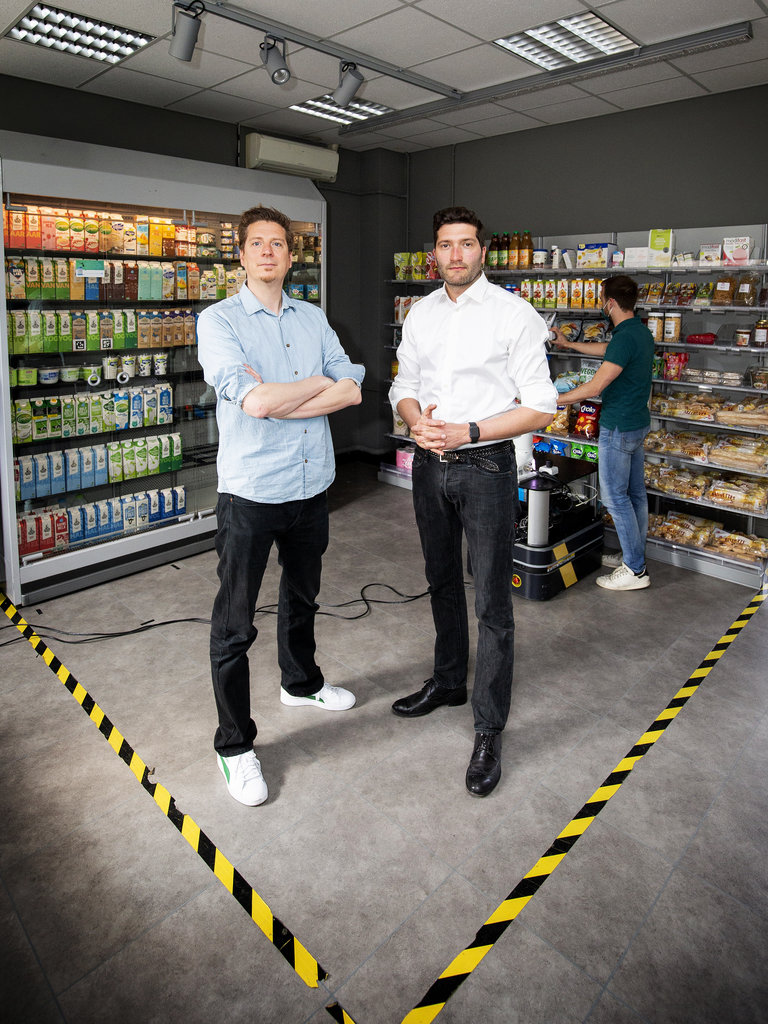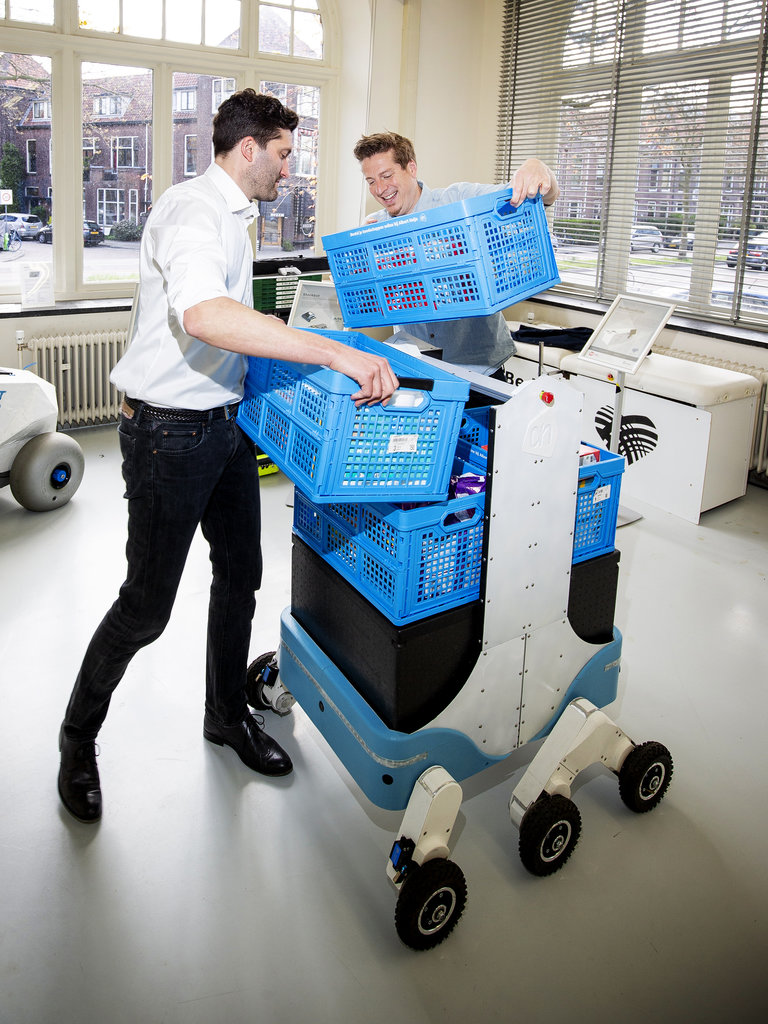
The future of work: workers and robots improving each other
By Bennie Mols
The new FRAIM research centre is set to focus on the future of work. It is based on the idea that higher productivity should go hand-in-hand with more meaningful work. FRAIM aims to achieve this by enabling workers and robots to learn from each other.
Some sixty years ago, US company General Motors introduced the very first industrial robot for spray painting in a car factory – the Unimate robot arm. In the six decades since then, robots have evolved from static, dangerous and extremely heavy machines only capable of helping to manufacture cars from behind secure fencing into mobile, safe, flexible and communicating devices that can sometimes work side-by-side with humans.
However, despite these impressive developments, their practical application in the world of work has yet to meet the expectations of society and industry. Working processes are often so complex, varied and dynamic that robots are still too limited for them and excellent prototypes all too often sit unused in a corner.
“In order to significantly accelerate robot innovation, we’re setting up a new research centre on TU Delft Campus, called FRAIM”, explains Jaimy Siebel, currently managing director of RoboValley and soon-to-be operational director of FRAIM. “In this new research centre, we want to enable workers and robots to learn from each other at work. FRAIM has been inspired by a vision of work that is about more than just productivity, but also what’s meaningful and valuable to individuals and society. At the research centre, we will develop technology by combining engineering and social sciences, and also by making use of workers’ and organizations’ non-academic knowledge.”

Our current robotics ecosystem, started in 2015, attempts to keep robot innovation reasonably close to the market. However, what we still lack is a holistic understanding of the impact a robot has on processes at work.
Jaimy Siebel, Managing Director at RoboHouse
Meaningful work
As the population in the Netherlands continues to age, fewer working people will need to produce and care for larger numbers of people who are not working. In order to make that possible, the use of robots for parts of the work will be essential. Equally, people also want to continue to do meaningful work. “FRAIM aims to provide an answer to the question of how humans and robots can collaborate symbiotically at work”, says David Abbink, professor of haptic human-robot interaction at TU Delft and the future director of research at FRAIM.
Abbink: “We’re familiar with symbiosis from biology as long-term relationships between two different organisms that are beneficial to both. At FRAIM, we aim to achieve something similar between workers and robots. They should be able to challenge and help each other to grow. FRAIM sees collaboration between workers and robots as a reciprocal long-term relationship that lives and grows, just like different organisms work together in nature.”
In around three years’ time, FRAIM will have its own building on the TU Delft Campus, alongside YES!Delft. The building will have its own working labs: unique laboratories in which both technological developments and social processes can be studied simultaneously in a work setting. Five overarching themes have already been agreed on: production processes, retail trade, manufacturing industry, care, and agriculture & nutrition. Ultimately, FRAIM aims to focus its research on ten specific themes.
The first three labs are to be established in September of this year, based for the time being on the site of the current RoboHouse field lab. The brand name FRAIM will be launched in the course of this year. Siebel: “Our current robotics ecosystem, started in 2015, attempts to keep robot innovation reasonably close to the market. However, what we still lack is a holistic understanding of the impact a robot has on processes at work.”
We’re familiar with symbiosis from biology as long-term relationships between two different organisms that are beneficial to both. At FRAIM, we aim to achieve something similar between workers and robots. They should be able to challenge and help each other to grow.
David Abbink, Full Professor Haptic Human-Robot Interaction at Delft University of Technology
New way of research
According to Prof. David Abbink, the future of work serves as an excellent lens for bringing together numerous scientific questions from the worlds of technology, sociology, psychology, anthropology and even politics. “I’ve been working on human-robot interaction for years, always limiting myself to a single human and a single robot. We often test my designs in brief experiments. But day-to-day practice won’t be about brief interactions, but long-term relationships within changing organizations. A reductionist perspective doesn’t help if you want to understand and shape the relationship between learning worker, learning robot and learning organization. FRAIM’s scientific ambition will be holistic and transdisciplinary: we intend to involve both the social and human sciences in the technical design and development processes.”
For example, Abbink is considering using qualitative research techniques from ethnography in order to study alternative ways of organizing work, and quantitative techniques from psychology to monitor people’s experiences at work every 15 minutes.
How do Abbink and Siebel envisage FRAIM in five years’ time?
Abbink: “By then, I hope we will have created a vibrant scientific community conducting pioneering research that links in seamlessly with people’s everyday reality at work. Someone from a company will then be able to walk into one of our labs and physically experience what the future of work will look like.”
Leading institute
Siebel: “I hope that, in five years, FRAIM will have become a leading European, and hopefully international, research centre in the field of the work of the future – a place where companies, organizations, researchers, talented scientists and start-ups are working on the future of our working processes.”
What constitutes a symbiotic relationship between worker and robot?
For decades, robots had no brains and artificial intelligence had no body. However, robots and AI have been coming closer together in recent years. Thanks to new AI technologies, robot brains are improving all the time. They can see, move, manipulate and learn better.
This kind of robot is known as a cognitive robot. Currently, they are mainly being developed in labs, and their future applications include robots that can support nursing staff with physical tasks in healthcare and robots that help people in supermarkets or with logistical processes.
If cognitive robots are to collaborate effectively with humans at work, they need to meet five basic conditions. These basic conditions, devised by Prof. David Abbink, will also be central to FRAIM as an institute.
- Robots must be safe (not inflict damage on humans), they must be secure (against cyberattacks) and they need to be sustainable (energy- and material-efficient).
- Robots must be responsive: a robot needs to understand what a human is capable of and wants to do, and what not; it must be possible for the robot to be adjusted intuitively by different people.
- Robots must make transparent decisions: workers need to understand what a robot is capable of and wants to do and why. Only if these conditions are met, will workers and organisations also be able to take responsibility for the work done jointly with the robot.
- Robots need to be versatile and not solely capable of completing one specialist task in a specialist context. They also need to be able to collaborate with a variety of workers.
- Robots need to challenge humans: workers must not be robots’ slaves who only do mind-numbing tasks that robots cannot do, but must be challenged to improve their own skills.